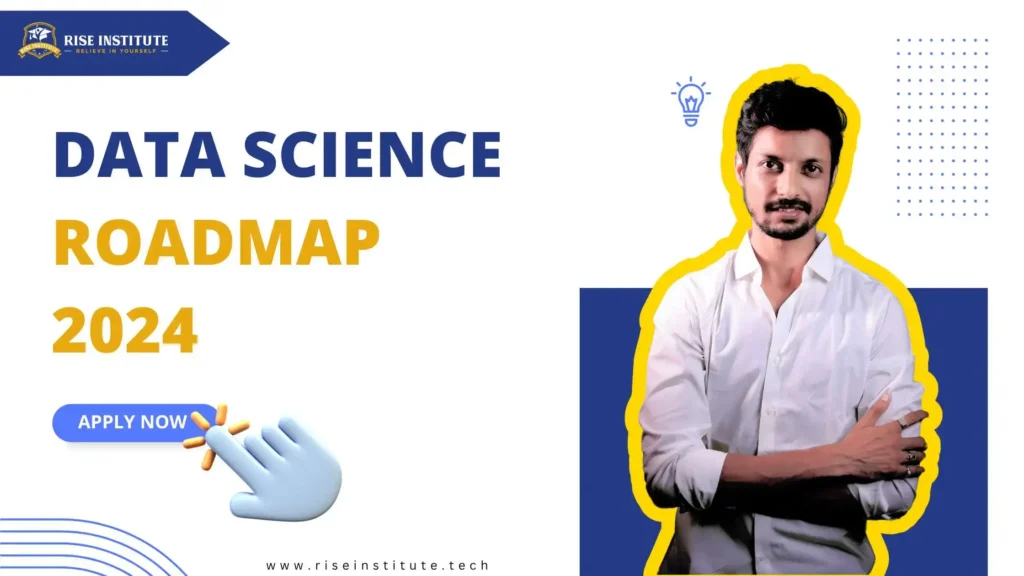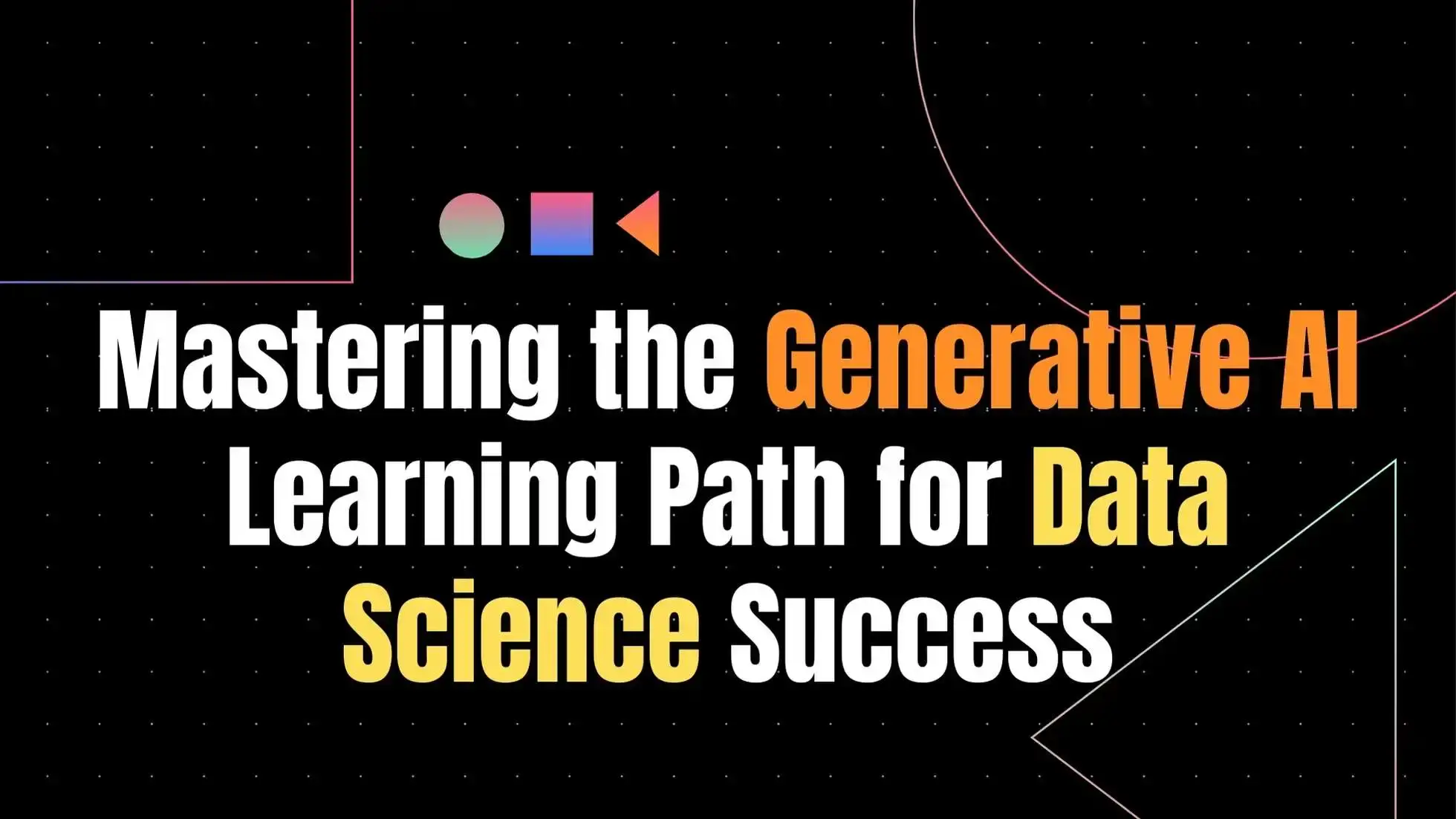Introduction:
In today’s digital age, data science has emerged as a crucial field driving innovation, efficiency, and decision-making across various industries. Whether you’re a seasoned professional or a novice enthusiast, navigating the vast landscape of data science can be overwhelming without a clear roadmap. In this guide, we’ll provide you with a comprehensive data science roadmap, equipping you with the essential knowledge and skills to embark on this transformative journey.
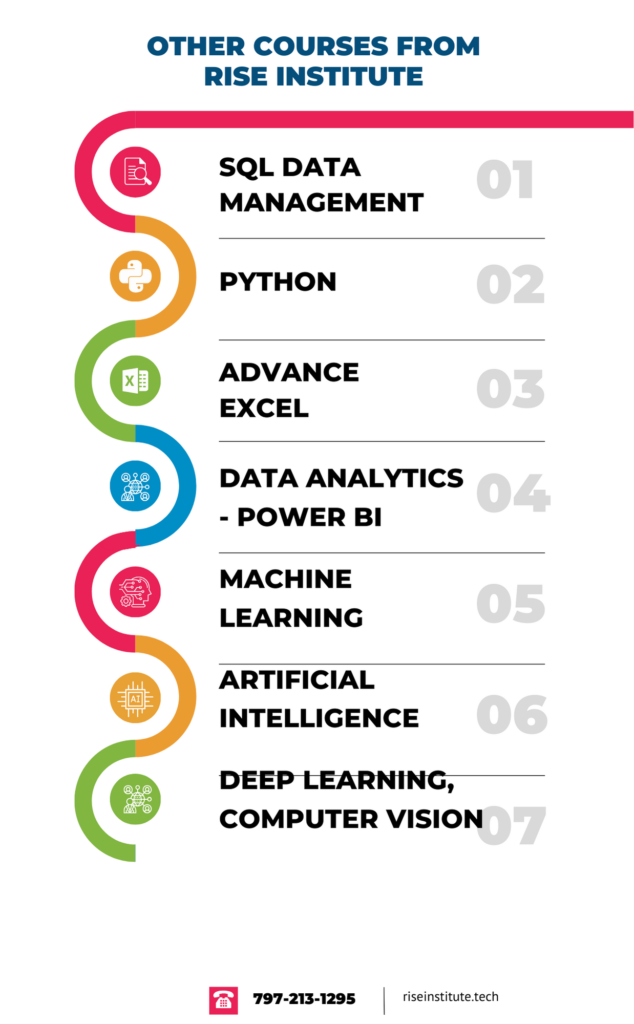
Chapter 1: Understanding Data Science
To embark on your data science journey, it’s crucial to first grasp the fundamentals of this dynamic field. Data science revolves around extracting insights and knowledge from structured and unstructured data using various techniques such as machine learning, statistical analysis, and data visualization. By understanding the core concepts of data science, you lay a solid foundation for your learning path.
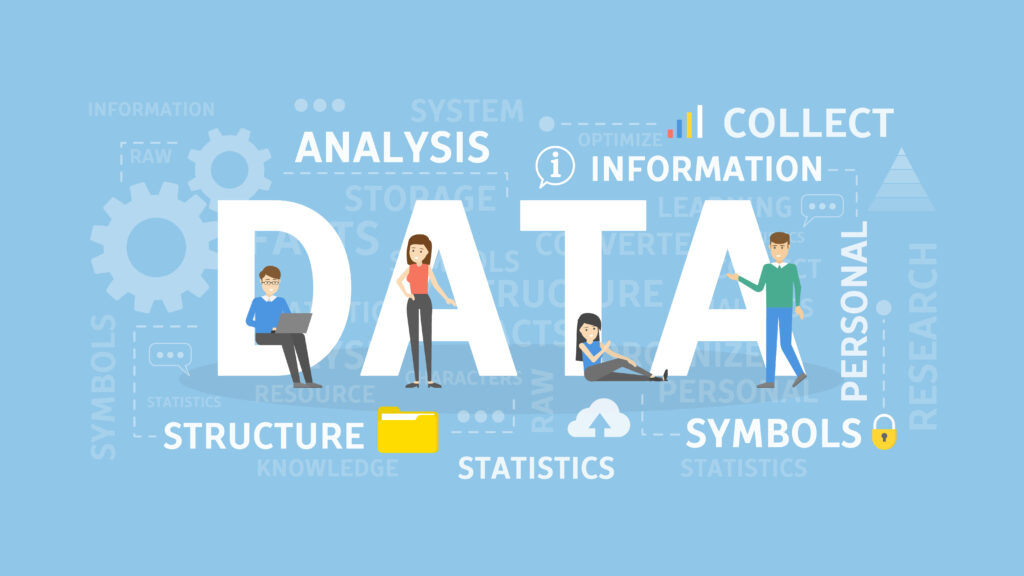
Chapter 2: Essential Skills for Data Science
Mastering data science requires a multifaceted skill set that seamlessly integrates technical prowess with analytical acumen and problem-solving finesse. The data science roadmap delineates the trajectory towards proficiency in this field, emphasizing the acquisition of essential competencies. Central to this roadmap is the cultivation of expertise in programming languages such as Python and R, pivotal tools for data manipulation and statistical analysis. Mastery of these languages forms the cornerstone of proficiency in data science, enabling practitioners to navigate complex datasets and extract meaningful insights.
Moreover, familiarity with machine learning algorithms constitutes another crucial waypoint on the data science roadmap.
As the backbone of predictive modeling and pattern recognition, understanding these algorithms is paramount for leveraging the full potential of data science techniques.
Whether it’s classification, regression, or clustering, a comprehensive grasp of machine learning algorithms empowers data scientists to derive actionable intelligence from raw data.
In addition to technical skills, effective communication and collaboration represent integral components of the data science roadmap. As data science projects often involve interdisciplinary teams and stakeholders with diverse backgrounds, the ability to convey insights concisely and collaborate seamlessly is indispensable. Data scientists must articulate their findings in a manner comprehensible to non-technical stakeholders, bridging the gap between data analysis and actionable decision-making.
Furthermore, the data science roadmap underscores the importance of continuous learning and professional development. Given the rapid evolution of technology and methodologies in this field, staying abreast of emerging trends and best practices is imperative for remaining competitive. Engaging in ongoing education, whether through online courses, workshops, or industry conferences, equips data scientists with the latest tools and techniques to tackle new challenges and opportunities.
Ultimately, excelling in data science requires a strategic approach guided by the data science roadmap. By systematically honing technical skills, fostering effective communication, and embracing lifelong learning, aspiring data scientists can navigate the complexities of this dynamic field with confidence and proficiency.
As they progress along this roadmap, they not only enhance their individual capabilities but also contribute to the broader advancement of data science as a transformative force in the digital era.
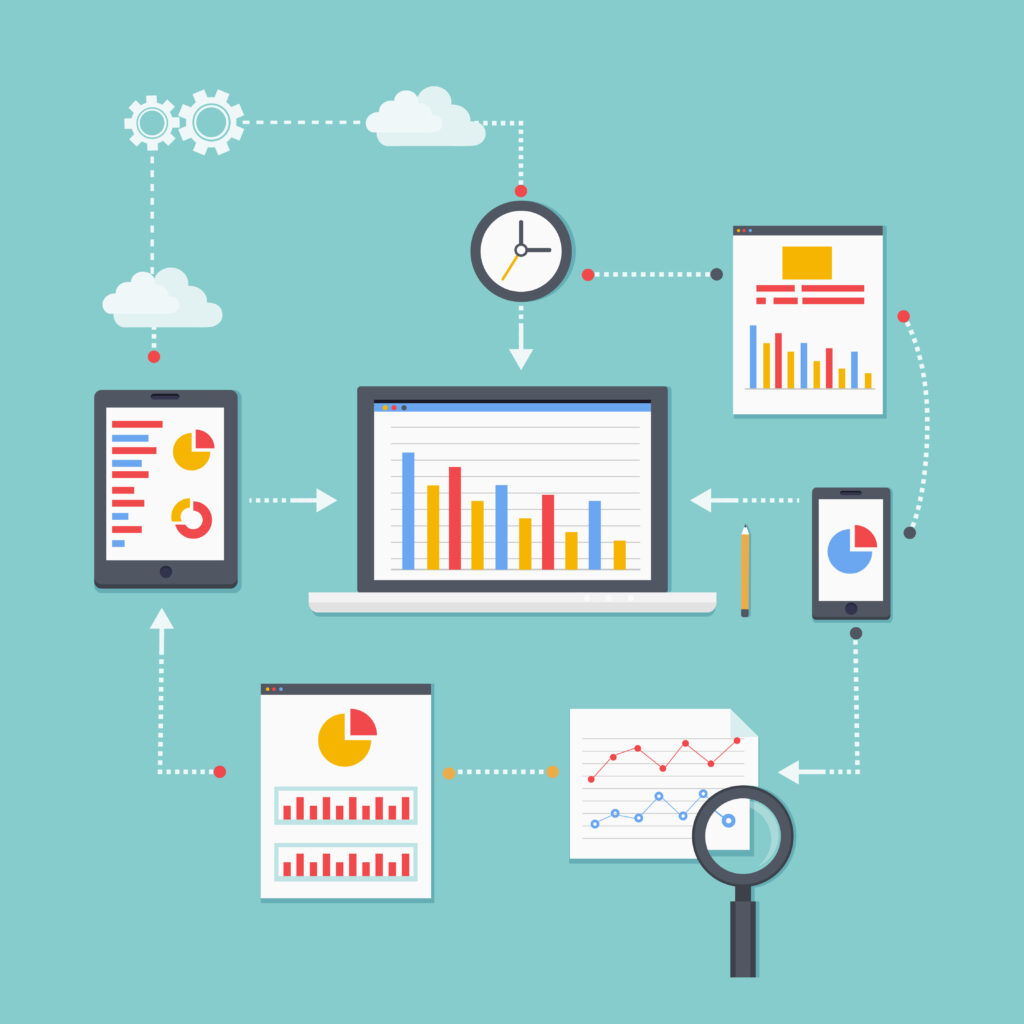
Chapter 3: Learning Resources and Tools
The expansive universe of data science is brimming with an abundance of learning resources and tools meticulously crafted to facilitate your journey along the data science roadmap. In this digital age, platforms such as Coursera, Udacity, and edX emerge as beacons of knowledge, offering a plethora of meticulously curated courses tailored to every milestone along the data science roadmap. From foundational principles to intricate concepts encompassing advanced machine learning algorithms, these platforms serve as indispensable allies in your quest for mastery.
Furthermore, the landscape of data science is enriched by a myriad of open-source tools, each a potent instrument in the hands of the aspiring data scientist. Tools like Jupyter Notebooks, Pandas, and TensorFlow constitute the bedrock upon which practical experience is cultivated, providing a hands-on approach to data analysis and visualization. With these tools at your disposal, you embark on a journey of discovery, traversing the data science roadmap with confidence and clarity.
Embracing the data science roadmap entails a continuous quest for knowledge and proficiency, and these platforms and tools stand as steadfast companions in your pursuit. As you navigate the intricate pathways of data science, each resource becomes a guiding light, illuminating the way forward and empowering you to surmount obstacles with ease. Whether you’re delving into the intricacies of statistical analysis or delving deep into the realm of predictive modeling, these resources equip you with the skills and insights necessary to thrive in the dynamic landscape of data science.
Moreover, these learning resources serve as conduits for staying abreast of the latest trends and developments within the field of data science. As the landscape evolves and new methodologies emerge, these platforms act as vanguards of innovation, offering cutting-edge courses and modules designed to keep you ahead of the curve. Through continuous learning and exploration, you remain poised to embrace the ever-changing landscape of data science, armed with the knowledge and tools to adapt and excel.
In essence, the world of data science is a vibrant ecosystem teeming with opportunities for growth and discovery. By leveraging the wealth of learning resources and tools available, you embark on a transformative journey along the data science roadmap, charting a course towards mastery and success. With each step forward, you deepen your understanding, refine your skills, and expand your horizons, ultimately emerging as a proficient and accomplished data scientist ready to tackle the challenges of tomorrow.
Chapter 4: Building a Portfolio
As you navigate your data science roadmap, one crucial milestone stands out: building a robust portfolio. This portfolio serves as a showcase, spotlighting your skills and expertise to prospective employers. It’s not just a mere collection of projects; it’s a testament to your proficiency in solving intricate problems through data science methodologies. With each project meticulously crafted and curated, you add layers of depth to your portfolio, bolstering your credibility as a data scientist.
But how do you go about constructing this vital tool on platforms like Naukri, LinkedIn, or others? Let’s dive into the intricacies of crafting compelling job descriptions and resumes tailored for these platforms.
When crafting job descriptions, start by outlining your key responsibilities and achievements in previous roles. Highlight your data science skills and experiences, emphasizing your contributions to projects and their impact on business outcomes. Use action-oriented language and quantifiable metrics whenever possible to demonstrate your effectiveness.
Next, tailor your resume to align with the requirements of potential employers. Start with a clear and concise summary that highlights your data science expertise and career objectives. Include a section dedicated to your technical skills, showcasing your proficiency in programming languages, statistical analysis, and machine learning algorithms.
In the experience section, detail your relevant work history, focusing on projects where you applied data science techniques to solve real-world problems. Use bullet points to highlight specific achievements and outcomes, quantifying your contributions whenever feasible.
Additionally, consider including a section for certifications, courses, and other professional development activities related to data science. This demonstrates your commitment to continuous learning and staying updated with industry trends.
Finally, don’t forget to optimize your resume with relevant keywords to increase its visibility to recruiters and hiring managers. Tailor the language to match the job descriptions of positions you’re interested in, ensuring that your resume stands out in a competitive field.
By following these guidelines and leveraging the power of platforms like Naukri and LinkedIn, you can effectively showcase your data science skills and expertise, positioning yourself as a top candidate in today’s job market. As you progress along your data science roadmap, your portfolio and resume will serve as invaluable tools, opening doors to exciting career opportunities in this dynamic field.

Chapter 5: Networking and Professional Development
Networking serves as a foundational pillar in the journey of career progression, especially within the expansive domain of data science. The intricate pathways delineated within the data science roadmap underscore the vital role networking plays in steering one’s professional trajectory towards unprecedented heights. As emphasized by the data science roadmap, active involvement in professional associations such as the Data Science Association, coupled with consistent attendance at industry symposiums and conferences, acts as a gateway to unlocking a plethora of invaluable opportunities. These platforms not only facilitate the cultivation of meaningful connections with peers, seasoned mentors, and prospective employers but also serve as fertile grounds for intellectual exchange, insight acquisition, and potential career advancements.
Further exploration into the expansive landscape illuminated by the data science roadmap reveals the equally pivotal role played by digital networking platforms in nurturing one’s professional growth and development. Participation in vibrant online communities such as Kaggle and GitHub emerges as an indispensable facet in the pursuit of excellence within the data science arena. These virtual arenas provide an immersive environment conducive to collaborative endeavors, where individuals converge to tackle intricate projects, share domain expertise, and remain abreast of the dynamic currents of innovation permeating the field. Through active engagement in such digital ecosystems, practitioners not only augment their knowledge base and skill set but also fortify their presence within the broader data science community.
In essence, networking transcends the realms of mere interaction to emerge as a potent catalyst for career advancement and personal growth within the data science landscape. As articulated within the data science roadmap, cultivating a robust professional network not only facilitates access to a plethora of career opportunities but also fosters a vibrant ecosystem of knowledge exchange and collaboration. Whether navigating the physical avenues of industry gatherings or traversing the digital byways of online communities, the data science roadmap underscores the indispensable role of networking in shaping one’s journey towards success and fulfillment within this dynamic and ever-evolving field.
But how does one construct this vital tool on platforms like Naukri, LinkedIn, or others? Let’s delve into the intricacies of crafting compelling job descriptions and resumes tailored for these platforms.
When crafting job descriptions, begin by outlining key responsibilities and achievements in previous roles. Highlighting data science skills and experiences, while emphasizing contributions to projects and their impact on business outcomes, is crucial. Utilize action-oriented language and quantifiable metrics wherever possible to showcase effectiveness.
Next, tailor your resume to align with the requirements of potential employers. Begin with a clear and concise summary that highlights data science expertise and career objectives. Include a section dedicated to technical skills, showcasing proficiency in programming languages, statistical analysis, and machine learning algorithms.
In the experience section, detail relevant work history, focusing on projects where data science techniques were applied to solve real-world problems. Use bullet points to highlight specific achievements and outcomes, quantifying contributions whenever feasible.
Consider including a section for certifications, courses, and other professional development activities related to data science to demonstrate commitment to continuous learning and staying updated with industry trends.
Lastly, optimize your resume with relevant keywords to increase visibility to recruiters and hiring managers. Tailoring language to match job descriptions of positions you’re interested in ensures your resume stands out in a competitive field.
Following these guidelines and leveraging the power of platforms like Naukri and LinkedIn effectively showcases data science skills and expertise, positioning candidates as top contenders in today’s job market. As one progresses along their data science roadmap, their portfolio and resume serve as invaluable tools, opening doors to exciting career opportunities in this dynamic field.
Delving deeper into the expansive landscape illuminated by the data science roadmap, it becomes apparent that digital networking platforms play an equally pivotal role in nurturing one’s professional growth and development. Participation in vibrant online communities such as Kaggle and GitHub emerges as an indispensable facet in the pursuit of excellence within the data science arena. These virtual arenas provide an immersive environment conducive to collaborative endeavors, where individuals converge to tackle intricate projects, share domain expertise, and stay attuned to the dynamic currents of innovation permeating the field. Through active engagement in such digital ecosystems, practitioners not only augment their knowledge base and skill set but also fortify their presence within the broader data science community.
In essence, networking transcends the realms of mere interaction to emerge as a potent catalyst for career advancement and personal growth within the data science landscape. As articulated within the data science roadmap, cultivating a robust professional network facilitates not only access to a plethora of career opportunities but also fosters a vibrant ecosystem of knowledge exchange and collaboration. Whether traversing the physical avenues of industry gatherings or navigating the digital byways of online communities, the data science roadmap underscores the indispensable role of networking in shaping one’s journey towards success and fulfillment within this dynamic and ever-evolving field.
But how do you go about constructing this vital tool on platforms like Naukri, LinkedIn, or others? Let’s delve into the intricacies of crafting compelling job descriptions and resumes tailored for these platforms.
When crafting job descriptions, start by outlining your key responsibilities and achievements in previous roles. Highlight your data science skills and experiences, emphasizing your contributions to projects and their impact on business outcomes. Use action-oriented language and quantifiable metrics whenever possible to demonstrate your effectiveness.
Next, tailor your resume to align with the requirements of potential employers. Start with a clear and concise summary that highlights your data science expertise and career objectives. Include a section dedicated to your technical skills, showcasing your proficiency in programming languages, statistical analysis, and machine learning algorithms.
In the experience section, detail your relevant work history, focusing on projects where you applied data science techniques to solve real-world problems. Use bullet points to highlight specific achievements and outcomes, quantifying your contributions whenever feasible.
Additionally, consider including a section for certifications, courses, and other professional development activities related to data science. This demonstrates your commitment to continuous learning and staying updated with industry trends.
Finally, don’t forget to optimize your resume with relevant keywords to increase its visibility to recruiters and hiring managers. Tailor the language to match the job descriptions of positions you’re interested in, ensuring that your resume stands out in a competitive field.
By following these guidelines and leveraging the power of platforms like Naukri and LinkedIn, you can effectively showcase your data science skills and expertise, positioning yourself as a top candidate in today’s job market. As you progress along your data science roadmap, your portfolio and resume will serve as invaluable tools, opening doors to exciting career opportunities in this dynamic field.
Chapter 6: Landing Your Dream Job
In the vast expanse of data science, a meticulously crafted data science roadmap stands as your guiding beacon, illuminating the path forward. This roadmap, intricately woven with a deep understanding of data science principles at every turn of your educational journey, bestows upon you a profound comprehension of the fundamental tenets, methodologies, and evolving techniques shaping this dynamic domain. Armed with this foundational knowledge, complemented by a diverse skill set honed through immersive experiences and continual learning, you emerge as a formidable contender within the competitive realm of data science.
Your data science roadmap not only serves as a blueprint for personal advancement but also opens doors to promising career horizons. A compelling portfolio, painstakingly curated to showcase your capabilities and achievements, acts as a testament to your proficiency, leaving an indelible mark on potential employers. Each project meticulously selected and articulated within your portfolio serves as a window into your problem-solving prowess, analytical finesse, and innovative mindset.
However, the journey extends beyond this horizon. To fully leverage the opportunities mapped out within your data science roadmap, proactive engagement in the job market becomes essential. Tailoring your resume to align seamlessly with the distinct requirements of each opportunity not only accentuates your pertinent experience and skills but also underscores your perceptive understanding of industry nuances and demands.
In your pursuit of career progression, online job portals emerge as indispensable tools, offering an abundance of untapped opportunities awaiting discovery. Platforms like LinkedIn, Indeed, and Glassdoor serve as virtual gateways to a plethora of job openings spanning diverse industries and organizations. Harnessing the potential of these platforms, you gain access to a diverse array of roles, each promising growth and fulfillment in equal measure.
Yet, the realization of your aspirations within data science demands more than mere application submission. As you navigate the intricate pathways of the hiring process, meticulous preparation assumes paramount importance. Engage in coding challenges, partake in mock interviews, and meticulously dissect past projects, extracting invaluable insights and learning from every endeavor.
In essence, your data science roadmap emerges as the bedrock of your career trajectory, guiding your decisions, shaping your trajectory, and propelling you toward success. With each milestone achieved, each skill honed, and each opportunity embraced, you edge closer to unlocking your full potential within the dynamic realm of data science.
In navigating the labyrinthine landscape of job hunting within the data science domain, strategic utilization of online platforms proves invaluable. Leveraging dedicated job portals like LinkedIn, Indeed, and Glassdoor can offer unparalleled access to an extensive array of employment opportunities tailored to your skillset and aspirations. These platforms serve as conduits connecting aspiring data scientists with prospective employers, facilitating seamless interactions and fostering mutually beneficial engagements.
Furthermore, meticulous preparation is essential to excel in the competitive landscape of data science job interviews. Engaging in rigorous practice sessions to tackle coding challenges and refine problem-solving abilities can bolster your confidence and readiness to tackle any obstacles that may arise during interviews. Moreover, articulating your involvement in past projects with clarity and precision, while elucidating the methodologies employed and the insights gleaned, can showcase your prowess effectively.
By adhering to these strategic approaches and embracing the tenets of the data science roadmap, you can navigate the intricacies of the job market with finesse and aplomb. Armed with a potent combination of knowledge, skills, and a compelling portfolio, you possess the requisite tools to unlock a world of exciting career opportunities within the expansive realm of data science. As you embark on this transformative journey, remember that perseverance, diligence, and strategic foresight are the guiding beacons illuminating your path towards success in the exhilarating domain of data science.
Your data science roadmap not only serves as a blueprint for personal growth but also paves the way for seizing promising career prospects. A compelling portfolio, meticulously curated to showcase your prowess and accomplishments, serves as a testament to your capabilities, leaving a lasting impression on potential employers. With each project meticulously selected and articulated, your portfolio becomes a window into your problem-solving prowess, analytical acumen, and innovative thinking.
However, the journey doesn’t end there. To fully leverage the opportunities presented by your data science roadmap, proactive engagement in the job market becomes imperative. Tailoring your resume to align with the specific requirements of each opportunity not only highlights your relevant experience and skills but also demonstrates your keen understanding of the industry landscape and its demands.
In your quest for career advancement, online job portals emerge as indispensable tools, offering a treasure trove of opportunities waiting to be unearthed. Platforms such as LinkedIn, Indeed, and Glassdoor serve as virtual gateways to a myriad of job openings across various industries and organizations. Leveraging the power of these platforms, you gain access to a diverse array of opportunities, each beckoning with the promise of growth and fulfillment.
Yet, securing your dream role in data science requires more than mere application submission. As you navigate the intricacies of the hiring process, meticulous preparation becomes paramount. Practice coding challenges, engage in mock interviews, and meticulously dissect your past projects, drawing insights and lessons learned.
In essence, your data science roadmap serves as the cornerstone of your career journey, guiding your steps, shaping your decisions, and propelling you towards success. With each milestone achieved, each skill acquired, and each opportunity seized, you inch closer to realizing your full potential in the dynamic realm of data science.
Delving deeper into the expansive landscape illuminated by the data science roadmap, it becomes apparent that digital networking platforms play an equally pivotal role in nurturing one’s professional growth and development. Participation in vibrant online communities such as Kaggle and GitHub emerges as an indispensable facet in the pursuit of excellence within the data science arena. These virtual arenas provide an immersive environment conducive to collaborative endeavors, where individuals converge to tackle intricate projects, share domain expertise, and stay attuned to the dynamic currents of innovation permeating the field. Through active engagement in such digital ecosystems, practitioners not only augment their knowledge base and skill set but also fortify their presence within the broader data science community.
In essence, networking transcends the realms of mere interaction to emerge as a potent catalyst for career advancement and personal growth within the data science landscape. As articulated within the data science roadmap, cultivating a robust professional network facilitates not only access to a plethora of career opportunities but also fosters a vibrant ecosystem of knowledge exchange and collaboration. Whether traversing the physical avenues of industry gatherings or navigating the digital byways of online communities, the data science roadmap underscores the indispensable role of networking in shaping one’s journey towards success and fulfillment within this dynamic and ever-evolving field.
But how do you go about constructing this vital tool on platforms like Naukri, LinkedIn, or others? Let’s dive into the intricacies of crafting compelling job descriptions and resumes tailored for these platforms.
When crafting job descriptions, start by outlining your key responsibilities and achievements in previous roles. Highlight your data science skills and experiences, emphasizing your contributions to projects and their impact on business outcomes. Use action-oriented language and quantifiable metrics whenever possible to demonstrate your effectiveness.
Next, tailor your resume to align with the requirements of potential employers. Start with a clear and concise summary that highlights your data science expertise and career objectives. Include a section dedicated to your technical skills, showcasing your proficiency in programming languages, statistical analysis, and machine learning algorithms.
In the experience section, detail your relevant work history, focusing on projects where you applied data science techniques to solve real-world problems. Use bullet points to highlight specific achievements and outcomes, quantifying your contributions whenever feasible.
Additionally, consider including a section for certifications, courses, and other professional development activities related to data science. This demonstrates your commitment to continuous learning and staying updated with industry trends.
Finally, don’t forget to optimize your resume with relevant keywords to increase its visibility to recruiters and hiring managers. Tailor the language to match the job descriptions of positions you’re interested in, ensuring that your resume stands out in a competitive field.
By following these guidelines and leveraging the power of platforms like Naukri and LinkedIn, you can effectively showcase your data science skills and expertise, positioning yourself as a top candidate in today’s job market. As you progress along your data science roadmap, your portfolio and resume will serve as invaluable tools, opening doors to exciting career opportunities in this dynamic field.
Conclusion:
Embarking on a data science journey is akin to setting sail into uncharted waters. The sheer vastness and complexity of this burgeoning field can often feel overwhelming, leaving aspiring data scientists adrift without a clear direction. However, armed with a meticulously crafted data science roadmap, you can chart a course with confidence and purpose.
A data science roadmap serves as your guiding compass, illuminating the path ahead and helping you navigate through the intricacies of this dynamic discipline. It provides a structured framework that outlines the essential steps and milestones needed to progress from novice enthusiast to seasoned practitioner.
Central to this roadmap is a deep understanding of the core concepts that underpin data science. From statistical analysis to machine learning algorithms, grasping these fundamentals lays the foundation upon which all subsequent knowledge and skills are built. By immersing yourself in the theory and principles of data science, you gain the insight and expertise needed to tackle real-world challenges head-on.
But theoretical knowledge alone is not enough. To truly excel in data science, you must also hone your practical skills through hands-on experience. This involves not only mastering programming languages and data manipulation techniques but also developing a keen eye for data visualization and interpretation. By honing these essential skills, you enhance your ability to extract actionable insights from raw data, making you a more effective and valuable data scientist.
In addition to technical proficiency, a robust portfolio is crucial for showcasing your abilities to potential employers and collaborators. Your portfolio should include a diverse range of projects that demonstrate your problem-solving prowess and creativity in applying data science techniques to real-world scenarios. Whether it’s predicting customer behavior, optimizing business processes, or uncovering hidden trends in data, each project serves as a testament to your expertise and ingenuity.
Furthermore, networking plays a pivotal role in advancing your career in data science. Engaging with peers, mentors, and industry professionals not only provides valuable insights and feedback but also opens doors to new opportunities. By actively participating in online communities, attending industry events, and seeking out mentorship, you can expand your professional network and gain invaluable connections that can propel your career forward.
Ultimately, by following a data science roadmap and diligently honing your skills, you can unlock your full potential as a data scientist. Armed with a deep understanding of the core concepts, a diverse portfolio of projects, and a strong network of peers and mentors, you can make meaningful contributions to innovation and impact in the digital age. So, set sail with confidence, for the journey ahead is ripe with opportunity and adventure.
Understanding the core concepts outlined in the roadmap is paramount to your journey’s success. Delving into the intricacies of machine learning algorithms, statistical analysis techniques, and data visualization methodologies lays the groundwork for your exploration. Each concept serves as a building block, enriching your understanding and fortifying your expertise in the realm of data science.
As you traverse the data science roadmap, honing essential skills becomes imperative. From mastering programming languages like Python and R to developing proficiency in data manipulation and interpretation, every skill acquired is a stepping stone towards proficiency. Furthermore, cultivating effective communication and collaboration skills is essential for conveying your insights and findings to stakeholders and collaborating with fellow data scientists.
Building a robust portfolio is a crucial checkpoint along the data science roadmap. Real-world projects that showcase your problem-solving prowess and analytical acumen not only bolster your credentials but also demonstrate your practical application of data science principles. Whether it’s predicting customer behavior, optimizing business processes, or uncovering actionable insights from complex datasets, each project adds depth and credibility to your portfolio.
Networking with peers and industry professionals is another essential aspect of the data science roadmap. Engaging in online communities, attending industry events, and seeking mentorship opportunities facilitate knowledge exchange and collaboration. By forging meaningful connections within the data science community, you gain valuable insights, mentorship, and potential career opportunities.
Seizing career opportunities is the ultimate objective of the data science roadmap. Armed with a comprehensive skill set, a robust portfolio, and a strong network, you are well-equipped to pursue diverse career paths in data science. Whether it’s joining a tech startup, working in academia, or leading data-driven initiatives in established enterprises, the possibilities are endless.
In conclusion, the data science roadmap serves as your indispensable guide on this transformative journey. By following its trajectory, understanding core concepts, honing essential skills, building a strong portfolio, networking with peers, and seizing career opportunities, you unlock your full potential as a data scientist. With determination, perseverance, and the right roadmap, you can make meaningful contributions to innovation and impact in the digital age.
Your data science roadmap not only serves as a blueprint for personal growth but also paves the way for seizing promising career prospects. A compelling portfolio, meticulously curated to showcase your prowess and accomplishments, serves as a testament to your capabilities, leaving a lasting impression on potential employers. With each project meticulously selected and articulated, your portfolio becomes a window into your problem-solving prowess, analytical acumen, and innovative thinking.
However, the journey doesn’t end there. To fully leverage the opportunities presented by your data science roadmap, proactive engagement in the job market becomes imperative. Tailoring your resume to align with the specific requirements of each opportunity not only highlights your relevant experience and skills but also demonstrates your keen understanding of the industry landscape and its demands.
In your quest for career advancement, online job portals emerge as indispensable tools, offering a treasure trove of opportunities waiting to be unearthed. Platforms such as LinkedIn, Indeed, and Glassdoor serve as virtual gateways to a myriad of job openings across various industries and organizations. Leveraging the power of these platforms, you gain access to a diverse array of opportunities, each beckoning with the promise of growth and fulfillment.
Yet, securing your dream role in data science requires more than mere application submission. As you navigate the intricacies of the hiring process, meticulous preparation becomes paramount. Practice coding challenges, engage in mock interviews, and meticulously dissect your past projects, drawing insights and lessons learned.
In essence, your data science roadmap serves as the cornerstone of your career journey, guiding your steps, shaping your decisions, and propelling you towards success. With each milestone achieved, each skill acquired, and each opportunity seized, you inch closer to realizing your full potential in the dynamic realm of data science.
Delving deeper into the expansive landscape illuminated by the data science roadmap, it becomes apparent that digital networking platforms play an equally pivotal role in nurturing one’s professional growth and development. Participation in vibrant online communities such as Kaggle and GitHub emerges as an indispensable facet in the pursuit of excellence within the data science arena. These virtual arenas provide an immersive environment conducive to collaborative endeavors, where individuals converge to tackle intricate projects, share domain expertise, and stay attuned to the dynamic currents of innovation permeating the field. Through active engagement in such digital ecosystems, practitioners not only augment their knowledge base and skill set but also fortify their presence within the broader data science community.
In essence, networking transcends the realms of mere interaction to emerge as a potent catalyst for career advancement and personal growth within the data science landscape. As articulated within the data science roadmap, cultivating a robust professional network facilitates not only access to a plethora of career opportunities but also fosters a vibrant ecosystem of knowledge exchange and collaboration. Whether traversing the physical avenues of industry gatherings or navigating the digital byways of online communities, the data science roadmap underscores the indispensable role of networking in shaping one’s journey towards success and fulfillment within this dynamic and ever-evolving field.
But how do you go about constructing this vital tool on platforms like Naukri, LinkedIn, or others? Let’s dive into the intricacies of crafting compelling job descriptions and resumes tailored for these platforms.
When crafting job descriptions, start by outlining your key responsibilities and achievements in previous roles. Highlight your data science skills and experiences, emphasizing your contributions to projects and their impact on business outcomes. Use action-oriented language and quantifiable metrics whenever possible to demonstrate your effectiveness.
Next, tailor your resume to align with the requirements of potential employers. Start with a clear and concise summary that highlights your data science expertise and career objectives. Include a section dedicated to your technical skills, showcasing your proficiency in programming languages, statistical analysis, and machine learning algorithms.
In the experience section, detail your relevant work history, focusing on projects where you applied data science techniques to solve real-world problems. Use bullet points to highlight specific achievements and outcomes, quantifying your contributions whenever feasible.
Additionally, consider including a section for certifications, courses, and other professional development activities related to data science. This demonstrates your commitment to continuous learning and staying updated with industry trends.
Finally, don’t forget to optimize your resume with relevant keywords to increase its visibility to recruiters and hiring managers. Tailor the language to match the job descriptions of positions you’re interested in, ensuring that your resume stands out in a competitive field.
By following these guidelines and leveraging the power of platforms like Naukri and LinkedIn, you can effectively showcase your data science skills and expertise, positioning yourself as a top candidate in today’s job market. As you progress along your data science roadmap, your portfolio and resume will serve as invaluable tools, opening doors to exciting career opportunities in this dynamic field.
Frequently Asked Questions (FAQ):
Q.1 I am BA/BCOM/BSC/B. Pharm etc…(non-technical), graduate can I apply this course?
Ans: Yes, of course, any graduate & FY, SY, TY can apply to this course.
Q.2. I have a distance Education degree. Is this eligible for this course?
Ans: Yes, You are eligible
Q.3. What is the duration of this course and its timings?
Ans: The total duration for this course is 5 to 6 months, and daily evening batch timings are : Monday to Saturday
-> Offline/Online Batch – 8:30 pm to 10:00 pm.
Q.4 What if I missed a single class?
Ans: Don’t worry. We have doubt sessions daily after class, and we will also provide you notes, repeated sessions & recorded sessions on important topics on a daily basis.
Q.5 What is about fee structure for this course?
Ans: Total Structure: Offline/Online
Fees Rs. 50000/-
(SQL+Database+Power BI+Python+ETL+AI+ML+Adv Excel)
Only SQL database Developer – 20,000/-
Only Power BI Developer – 20,000/-
🔰 Bajaj: No Cost EMI Starts from 6250/-
Q.6 Can I get work from home job?
Ans: yes, of course you can get work-from-home jobs also.
Q.7. Do you have weekend batches?
Ans- No, We don’t have any weekend batches
Q.8 English communication or fluency is compulsory?
Ans: No, if you have understandable English knowledge, that is more than sufficient.
Q.9. I am completely unaware of all those languages. Can I do this course by understanding all the difficulties?
Ans- Don’t worry. We will start the Project from Scratch, and you can easily understand it very well.
Q.10 Which programming language will you cover?
Ans: Technologies Covered
Power BI, SQL, Python, Artificial intelligence, Machine learning, Advance Excel.
Q.11 I am a diploma holder only. Can I apply for this course?
Ans:- No, Graduation or FY/SY/TY is mandatory to do this course.
Q.12 When will you take the mock session?
Ans:- Every Saturday 1:1 Mentorship & After 2 Months Expert Mock Interview on Every Sunday…
Q.13 I don’t know coding. Can I do this?
Ans:- Yes you can, attend the Introduction Session for detailed information about IT jobs…
Q.14 Is there Any chance after completing the course, I will get the job?
Ans:- Yes, 100%, If you study from the 1st day without missing a single session and follow the instructions given by our mentors.
Q.15 Do you provided videos of the session?
And – Yes, live session will be there, with Recorded else you can join the Offline Repeat batch.

